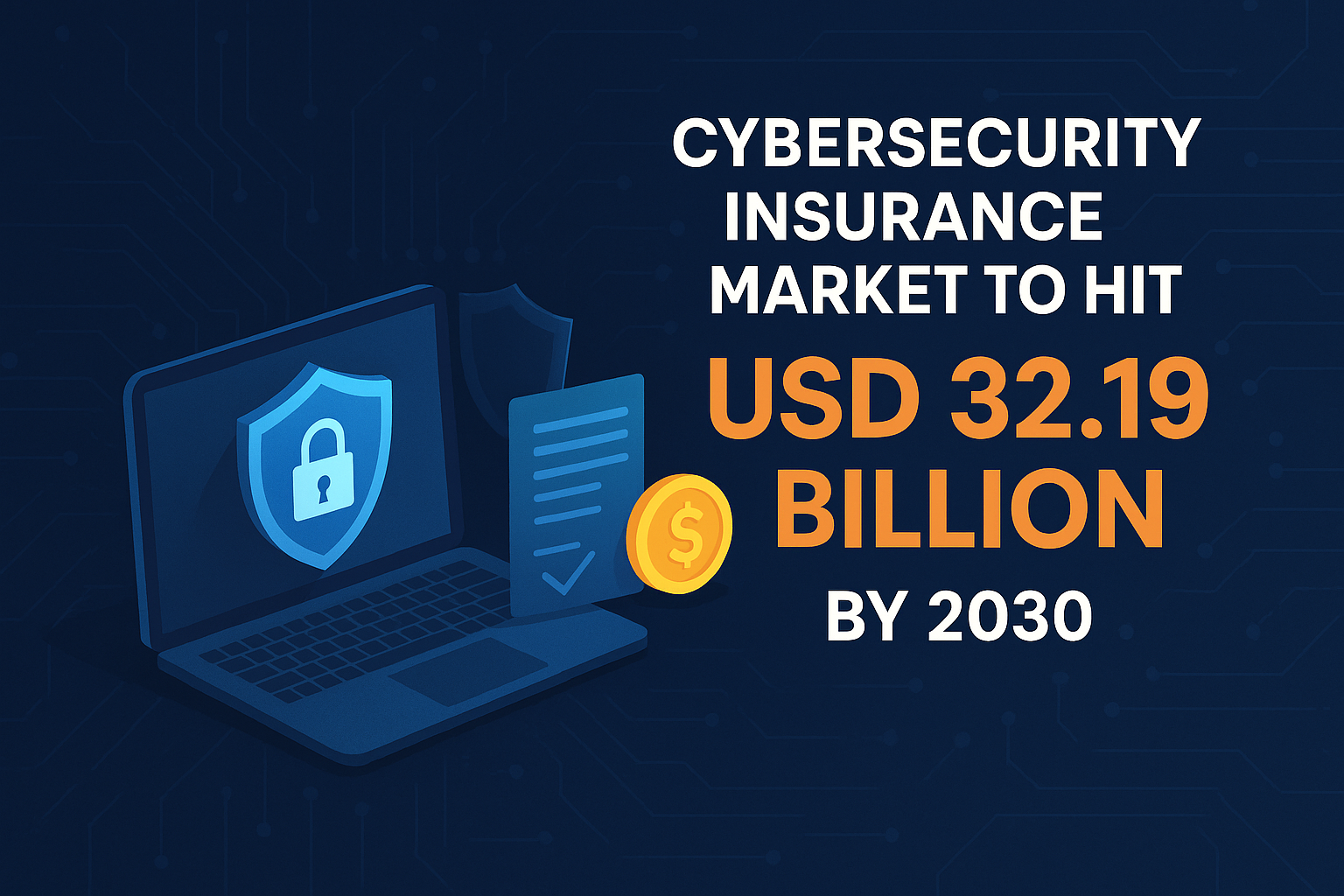Cybersecurity Insurance Market to Hit USD 32.19 Billion by 2030
In the digital age, where data is currency and breaches are battles, cybersecurity has become a non-negotiable priority for businesses across the globe. But as threats grow more complex and costly, companies are no longer relying solely on firewalls and antivirus software—they’re increasingly turning to a financial safety net: cybersecurity insurance.
Recent projections estimate the global cybersecurity insurance market will reach USD 32.19 billion by 2030, experiencing robust growth driven by rising cybercrime, regulatory pressure, and widespread digital transformation. This staggering figure reflects a profound shift in how organizations approach cyber risk—viewing it not just as a technical issue, but as a business-critical concern demanding strategic coverage.
In this blog, we’ll explore what’s behind this explosive growth, how the market is evolving, who’s buying in, and what it means for the future of digital resilience.
Understanding Cybersecurity Insurance: More Than Just a Policy
Cybersecurity insurance—also called cyber liability insurance—protects organizations from financial losses related to cyber incidents. These can include data breaches, ransomware attacks, business email compromise, system outages, and even social engineering scams.
A comprehensive policy typically covers:
- Legal fees and regulatory penalties
- Data breach response and forensic investigations
- Notification costs to inform affected customers
- Ransom payments in extortion scenarios
- Business interruption losses due to system downtime
- Reputation management and PR crisis recovery
What makes cyber insurance unique is that it doesn’t just protect digital assets—it cushions a business’s operational and reputational integrity in the aftermath of an attack.
The Market Trajectory: From Niche Offering to Global Necessity
Just a decade ago, cyber insurance was a niche product with limited adoption. Today, it’s one of the fastest-growing segments in the broader insurance and risk management sector.
📊 By the Numbers:
- Market Value in 2022: Approximately USD 12 billion
- Projected Value by 2030: USD 32.19 billion
- CAGR: Estimated between 17% and 20% annually
This upward trajectory is fueled by both external forces (cyber threats, regulations) and internal ones (risk perception, executive prioritization).
What’s Driving the Surge?
Several intertwined factors are pushing the cybersecurity insurance market toward this USD 32 billion milestone:
1. The Explosion of Cyber Threats
Cyberattacks are no longer rare events—they’re a daily reality for businesses. Whether it’s ransomware groups targeting hospitals or phishing campaigns aimed at banks, no industry is immune.
- Ransomware attacks have increased by over 60% year-over-year globally.
- The average cost of a data breach in 2024 is estimated at over $4.5 million, according to IBM’s annual Cost of a Data Breach Report.
As attackers become more sophisticated—leveraging AI, deepfakes, and dark web collaboration—insurance becomes a critical layer of defense.
2. Regulatory Pressures Are Rising
Governments worldwide are introducing strict data protection and privacy regulations that come with heavy penalties for non-compliance. Think:
- GDPR in the European Union
- CCPA in California
- DPDP Act in India
- Global cyber incident reporting laws
Companies that suffer a breach and fail to respond properly may face fines in the millions. Cyber insurance can help cover these liabilities and provide access to legal and compliance experts during a crisis.
3. Remote Work & Cloud Adoption
The shift to hybrid and remote workforces, coupled with rapid cloud migration, has expanded the attack surface. Traditional perimeter defenses are no longer sufficient, and insurers are now offering coverage tailored to cloud environments, endpoint vulnerabilities, and third-party SaaS exposure.
4. C-Suite and Board-Level Attention
Cybersecurity is now a boardroom issue. CEOs and CFOs understand that a major breach could not only cost millions but cripple brand trust and investor confidence. As a result, organizations are integrating cyber insurance into their broader risk management and governance frameworks.
Who’s Buying Cyber Insurance?
🏢 Large Enterprises
These organizations lead adoption due to greater awareness and exposure. Many Fortune 500 companies already have dedicated cyber insurance teams and brokers managing complex, multi-country policies.
🧑💼 Small and Medium-Sized Businesses (SMBs)
Ironically, SMBs are more vulnerable to cyberattacks but often underprepared. However, rising awareness and simplified policy offerings are making cyber insurance more accessible for this segment. Many insurers now offer “starter” packages tailored for SMBs with quick onboarding and predefined coverage limits.
💼 Highly Regulated Industries
Sectors dealing with sensitive data are the most enthusiastic adopters:
- Healthcare (HIPAA compliance, patient data)
- Finance (PCI DSS, fraud prevention)
- E-commerce & Retail (payment systems, consumer data)
- Education & Government (public infrastructure protection)
These industries not only face frequent attacks but also legal obligations to secure data and respond effectively.
Challenges in the Cyber Insurance Market
Despite the bullish outlook, the market isn’t without growing pains:
1. Underwriting Complexity
Traditional actuarial models don’t work well in cyber insurance. Risks evolve quickly, threat landscapes shift, and historical data is often insufficient. As a result, premiums can be high, and coverage may vary widely across providers.
2. Ambiguity in Coverage
Many policies include exclusions for:
- Nation-state attacks
- Acts of war
- Insider threats
- Non-compliance with security best practices
This can lead to disputes at the time of claim, making policy transparency and customer education critical.
3. Lack of Standardization
Cyber insurance is still a relatively young field. Different insurers use different language, terminology, and risk models. As a result, businesses often struggle to compare policies apples-to-apples.
Innovation & The Future of Cyber Insurance
As the market matures, technological innovation and industry collaboration are reshaping how cyber insurance is underwritten, delivered, and consumed.
💡 Insurtech Disruption
New-age insurance startups (like Coalition, At-Bay, and Cowbell) are using AI and machine learning to:
- Continuously scan clients’ IT environments
- Predict vulnerabilities in real time
- Offer “active insurance” that adapts dynamically to a business’s risk profile
These platforms often combine policy issuance with real-time cybersecurity tools—blurring the lines between insurance and IT security.
📈 Risk Scoring & Cyber Hygiene Incentives
Insurers are introducing cyber risk scores (similar to credit scores) to quantify organizational risk. Businesses with better security controls and employee training can earn lower premiums—similar to getting a discount for installing a home security system.
🤝 Public-Private Partnerships
As cyberattacks threaten critical infrastructure, governments may collaborate more closely with insurers. Expect to see shared threat intelligence databases, government-backed reinsurance models, and clearer legal frameworks for cross-border cyber incidents.
For example, the U.S. Department of Homeland Security’s Cybersecurity & Infrastructure Security Agency (CISA) is working closely with both private and public institutions to raise national cyber resilience.
Final Thoughts: Cyber Insurance as a Strategic Imperative
In today’s hyper-connected world, cyber threats aren’t just a technical challenge—they’re a strategic business risk. From ransomware takedowns to data privacy lawsuits, the fallout of cyber incidents can be swift and severe.
As the cybersecurity insurance market hurtles toward USD 32.19 billion by 2030, organizations of all sizes must rethink how they manage cyber risk. That means going beyond firewalls and antivirus software to include risk transfer strategies, such as insurance, that protect both digital assets and the bottom line.
🧭 Key Takeaways:
- Cyber insurance demand is rising due to escalating threats and regulatory pressure.
- Policies offer crucial financial and operational support post-breach.
- Market innovation is making coverage smarter, more accessible, and more proactive.
- Businesses that adopt cyber insurance today will be better prepared for tomorrow’s digital battles.
In the end, cybersecurity insurance isn’t just about recovering from the unexpected—it’s about being resilient by design.














Post Comment